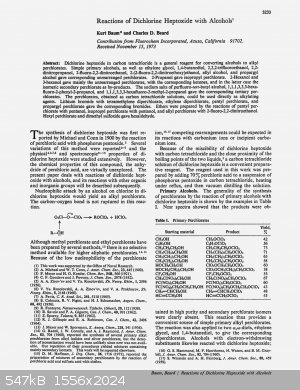| Pages:
1
..
5
6
7 |
Davin
Harmless

Posts: 36
Registered: 5-12-2012
Member Is Offline
Mood: No Mood
|
|
Thanks Dany!
|
|
|
BromicAcid
International Hazard
    
Posts: 3227
Registered: 13-7-2003
Location: Wisconsin
Member Is Offline
Mood: Rock n' Roll
|
|
Here are the first to pages of the Meyer&Spormann paper in English courtesy of the Wayback Archive. The rest of the images however were not
archived as far as I can tell. I can also dig up the Hare&Boye paper transcribed into Word. It was difficult to read so once upon a time I
copied it over.
http://www.destructve.com/sciencemadness/ms1.gif
http://www.destructve.com/sciencemadness/ms2.gif
|
|
|
Davin
Harmless

Posts: 36
Registered: 5-12-2012
Member Is Offline
Mood: No Mood
|
|
Thanks Bromic!
|
|
|
franklyn
International Hazard
    
Posts: 3026
Registered: 30-5-2006
Location: Da Big Apple
Member Is Offline
Mood: No Mood
|
|
Perchlorate polymers
Reactions of Dichlorine Heptoxide with alcohols
J. Am. Chem. Soc. 1974, 96, 10, 3233-3237
https://pubs.acs.org/doi/pdf/10.1021/ja00817a033
https://doi.org/10.1021/ja00817a033

Dichlorine Heptoxide in Carbon Tetrachloride is a general reagent for the facile oxidation of alcohols to alkyl perchlorates.
It's preparation from Perchloric acid obviates subsequent handling of the acid itself.
Propargyl alcohol H-CΞC-CH2OH for example is thus made in situ into Propargyl Perchlorate. H-CΞC-CH2-ClO4 => 3 CO + H2O + HCl .
Propargyl alcohol polymerizes , presenting the prospect of producing a perchlorate polymer.
Chloroethene monomer commonly known as Vinyl Chloride , H2:C=CH.Cl polymerizes into the familiar PVC plastic ( Poly Vinyl Chloride ) [CH2.CHCl]n
Ethenol known as Hydroxylethylene commonly known as Vinyl alcohol H2:C=CH.OH
may suitably be made into Vinyl Perchlorate H2:C=CH.ClO4 => CO2 + CO + H2O + HCl
and subsequently polymerized in the same way ( barring steric hindrance ) into a Poly Vinyl Perchlorate [CH2CHClO4]n
The highest density of PVC plastic is ~ 1.45 . Higher density can be anticipated in the perchlorate variant.
1,3,5-Trihydroxybenzene also known as 1,3,5-Benzenetriol commonly known as Phloroglucinol C6H3(OH)3
should readily be liable to form the Perchlorate , C6H3(ClO4)3 => 6 CO2 + 3 HCl
IMPORTANT CRITICAL PRACTICE FOR INVESTIGATION
https://sites.google.com/site/energeticchemical/alkyl-perchl...
.
[Edited on 2-1-2020 by franklyn]
Techniques to Disrupt, Deviate and Seize Control of
an Internet Forum In case you wonder W T F ! is going on here
?
www.zerohedge.com/contributed/2012-10-28/cointelpro-techniques-dilution-misdirection-and-control-internet-forum https://web.archive.org/web/20120814124000/www.washingtonsblog.com/2012/08/the-15-rules-of-internet-disinformation.html
___________________________________________________________________________________________________________________
___________________________________________________________________________________________________________________
___________________________________________________________________________________________________________________
|
|
|
| Pages:
1
..
5
6
7 |